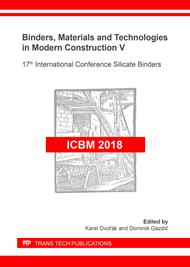p.99
p.105
p.112
p.118
p.125
p.131
p.137
p.143
p.149
Perspectives of Using Alternative Binders in the Preparation of Composites with Natural Filler
Abstract:
This paper reports on the possibility of using natural renewable materials as hemp fibers in the preparation of composites. The design and preparation of durable composites also requires the selection of suitable alternative binders, in order to reduce the production of carbon dioxide in the production of cement. The paper will present the results of composites with partial replacement of cement with natural clay, which was used in the traditional building in the past as classical binder. Experimental verification of mechanical, thermal and humidity parameters of composites was performed. The results confirmed some prospects for the use of experimental composites in terms of the compressive strengths values obtained after 28 days of maturing. Highest compressive strengths were measured for a reference set with 100% cement content and of course composites with increasing percentage cement replacement exhibited lower strengths. The results showed that replacing cement with natural clay does not create a new stronger material, but there is some potential for its use in the form of non-load-bearing elements. Experimental composites exhibited a relatively lower density compared to normal concrete, but the thermal conductivity values indicate the potential for their use as insulating materials.
Info:
Periodical:
Pages:
125-130
Citation:
Online since:
August 2019
Authors:
Keywords:
Price:
Сopyright:
© 2019 Trans Tech Publications Ltd. All Rights Reserved
Share:
Citation:


